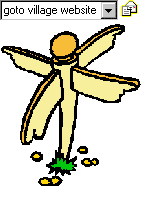The Elveden Estate
Elveden Eriswell Icklingham
A brief outline of the development of Elveden Estate during the ownership of
the Guinness family 1894 - to the present day.
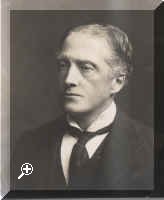 The
First Earl of Iveagh, Edward Cecil Guinness, purchased the Elveden Estate from
the Executors of Maharajah Duleep Singh in 1894. Lord Iveagh's main interest was
in the Shooting and Elveden was reputed to be one of the best Sporting Estates
in the country. The land was cultivated under a 4-course rotation, wheat or rye,
roots, barley or oats and seeds. Flocks of sheep were kept to tread and manure
the land which was mainly sand over chalk and needed nourishment to assist the
yields. In addition there was always a large acreage of crops such as buckwheat
and kidney vetch grown for feed and cover for the game birds.
The
First Earl of Iveagh, Edward Cecil Guinness, purchased the Elveden Estate from
the Executors of Maharajah Duleep Singh in 1894. Lord Iveagh's main interest was
in the Shooting and Elveden was reputed to be one of the best Sporting Estates
in the country. The land was cultivated under a 4-course rotation, wheat or rye,
roots, barley or oats and seeds. Flocks of sheep were kept to tread and manure
the land which was mainly sand over chalk and needed nourishment to assist the
yields. In addition there was always a large acreage of crops such as buckwheat
and kidney vetch grown for feed and cover for the game birds.
Throughout the Edwardian period the fame of the Elveden Shoot became widespread. Many notable people came to Elveden to enjoy the shooting and the Earl's
hospitality, among them Edward, Prince of Wales, later to become King Edward
V11, and his illustrious friends, all conveyed by carriages and later cars, from
Thetford Station, together with their personal servants, and a huge quantity of
trunks and boxes.
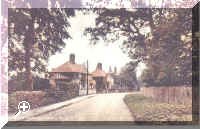 Lord
Iveagh increased the number of people employed, building
Lord
Iveagh increased the number of people employed, building new cottages to house the expanding population. New roads were laid and a
brick-works established in which the distinctively stamped 'Elveden' red-
new cottages to house the expanding population. New roads were laid and a
brick-works established in which the distinctively stamped 'Elveden' red- 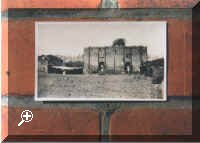 bricks
were made; a light railway was constructed to facilitate the movement of the
bricks and equipment to the various building sites. Lord Iveagh more than
doubled the size of the Hall; a wing was built to match the existing hall and
the two were joined, centrally, by an imposing copper-domed edifice. An
impressive servants' quarters was built and connected to the Hall's eastern end.
A branch railway line linking Barnham Station to Elveden was established - so
that a locomotive and trucks could transport materials, including marble and
stone, to where it would be needed for the construction of the Hall.
bricks
were made; a light railway was constructed to facilitate the movement of the
bricks and equipment to the various building sites. Lord Iveagh more than
doubled the size of the Hall; a wing was built to match the existing hall and
the two were joined, centrally, by an imposing copper-domed edifice. An
impressive servants' quarters was built and connected to the Hall's eastern end.
A branch railway line linking Barnham Station to Elveden was established - so
that a locomotive and trucks could transport materials, including marble and
stone, to where it would be needed for the construction of the Hall.
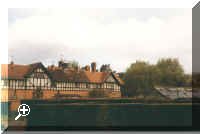 |
Other 'Elveden' red-brick buildings included a fine stables, |
| water tower , |
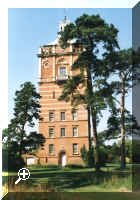 |
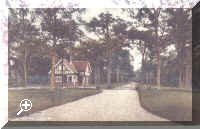 |
lodges , |
| post office |
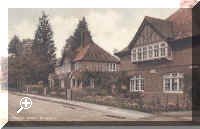
|
...the estate office, laundry,
school, rectory, gasworks and workshops were also of red brick.
In 1906 a beautiful church, designed by W.D.Caroe
and dedicated to St. Patrick was added to the existing mediaeval St. Andrew's
church, and in 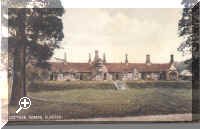 1912
the Cottage Homes were built for the elderly and retired employees. These
cottages were first used in 1914 as quarters for the Scots Guards training in
the Thetford area and, later, in 1916 by tank training officers: At this time a
large area of heathland from Elveden to just north of Icklingham had been chosen
as the then secret 'tank' training ground.
1912
the Cottage Homes were built for the elderly and retired employees. These
cottages were first used in 1914 as quarters for the Scots Guards training in
the Thetford area and, later, in 1916 by tank training officers: At this time a
large area of heathland from Elveden to just north of Icklingham had been chosen
as the then secret 'tank' training ground.
In 1914 with the onset of the Great War it was realised that Britain had to
try and feed herself, extra acreage was brought into cultivation to help the war
effort. The Game Department was 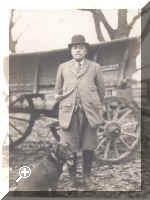 disbanded
during this period but Tom Turner, who had become the Head Gamekeeper in 1916,
continued after the war to rebuild the stocks and good bags were soon, once
again, the order of the day. King George V, a fine shot, was a frequent visitor
to Elveden, both before and after his accession, his son Albert, Duke of York,
later to become King George V1, also shot here.
disbanded
during this period but Tom Turner, who had become the Head Gamekeeper in 1916,
continued after the war to rebuild the stocks and good bags were soon, once
again, the order of the day. King George V, a fine shot, was a frequent visitor
to Elveden, both before and after his accession, his son Albert, Duke of York,
later to become King George V1, also shot here.
As well as providing sport the shooting of rabbits and game supplied a
considerable amount of food and helped to keep vermin under control.
Edward Cecil founded and endowed the Chadacre Agricultural Institute in 1921.
This was one of England's first agricultural institutes and its purpose was to
provide agricultural education to the sons of farm labourers, small holders and
farmers in Suffolk and surrounding counties.
The First Earl was a great philanthropist, amongst his many gifts was
included a large sum for scientific research and another to the Jenner Institute
of Medicine. He also gave his Kenwood House and the priceless collection of
paintings it contained to the nation.
Rupert, second Earl of Iveagh was in his early fifties when he inherited the
title and estates in 1927. He had by this time established his reputation as an
able politician and enthusiastic supporter of science. Lord Iveagh had earlier
persuaded his father to endow the Lister Institute of Preventive medicine and
served on the governing board; he became interested in the Wright-Fleming
Institute of microbiology .
Rupert also helped form the Tuberculin Tested Milk Producers Association
researching into the eradication of T.B. infected cattle. and was instrumental
in establishing the National Institute for Research into Dairying, at Shinfield,
Berkshire.
.
Rupert also helped form the Tuberculin Tested Milk Producers Association
researching into the eradication of T.B. infected cattle. and was instrumental
in establishing the National Institute for Research into Dairying, at Shinfield,
Berkshire.
In 1927 several of the most able students came from the Chadacre Agricultural
Institute, to assist in the transformation of the Elveden Estate and help him
with his revolutionary ideas. The brightest was a 21 year old Victor Harrison,
who arrived in 1933. Chadacre finally closed in 1989, but the Trust continues to
this day, chaired by the present Lord Iveagh, its income is used to support
agricultural research work.
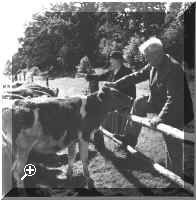 Lord
Iveagh realised the land had to be made more profitable and manure would be
needed and therefore, in 1932 commenced to buy in dairy cattle, keeping only
those which passed the TB Test. In 1927 there were 120 cows, by 1962 there were
715 plus 816 young stock. Lord and Lady Iveagh took a keen interest in their
Dairy Herds and prepared a 'family tree', which was regularly up dated, for
every animal in their possession.
Lord
Iveagh realised the land had to be made more profitable and manure would be
needed and therefore, in 1932 commenced to buy in dairy cattle, keeping only
those which passed the TB Test. In 1927 there were 120 cows, by 1962 there were
715 plus 816 young stock. Lord and Lady Iveagh took a keen interest in their
Dairy Herds and prepared a 'family tree', which was regularly up dated, for
every animal in their possession.
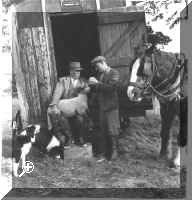 The
sheep flocks were sold in 1933 but reintroduced at a later date.
The
sheep flocks were sold in 1933 but reintroduced at a later date.
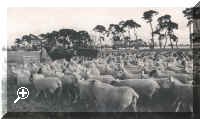
The acreage released was used to grow Lucerne, having very long roots,
sometimes six feet, it could penetrate much further in its search for water, and
as a member of the legume family nitrogen nodules grew on these roots. The leys
were cut for silage and grazed by the cattle over a three year period, then
ploughed in as green manure.
An experiment in 1933 to grow sugar beet on 5 acres was promising, this led
to 500 acres being grown in 1939.
At the outbreak of war the Ministry of Agricuture instigated a ploughing-up
campaign as part of the 'War Effort'. Lord Iveagh agreed to increase the arable
acreage as requested. 600 acres were ploughed, 200 hundred of which were lucerne
leys and the rest old lands which had been used for game and had gone out of
cultivation. This proved discouraging, the crops failing to cover the expense of
growing them. The following year Lord Iveagh was asked to plough another 1000
acres and agreed to make the attempt even though the previous efforts had proved
unsuccessful. All had to be fenced against rabbits and the wire was difficult to
obtain.
The new ground yielded more crops than anticipated, but later the whole
project was dealt a severe blow. The War Office announced its intention of using
a large area of the estate as a tank training ground and despite the need for
food production, many of the new crops were ruined, and fences torn down,
allowing the ingress of rabbits which were more destructive than the tanks.
After a great deal of damage had been done it was agreed to fence off small
areas of the land for cultivation which were later harvested. The value of the
ploughing-up experiment had been largely lost and an enormous amount of much
needed food had gone to waste. Undeterred, Lord Iveagh obtained permission from
the War Office to cultivate portions of the requisitioned lands which were
hardly used and by the end of the war had regained much of the lost ground -
which was successfully cropped. Leys had also been increased by another thousand
acres. Some of the extra acreage had been obtained from old pasture land but
most of it was gained from previously untouched heath.
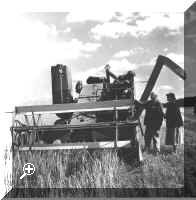 For several years the Forestry Commission had coveted parts of Elveden Estate
for extending Thetford Forest, but Lord Iveagh's success with farming brought a
settlement in his favour in 1952.
For several years the Forestry Commission had coveted parts of Elveden Estate
for extending Thetford Forest, but Lord Iveagh's success with farming brought a
settlement in his favour in 1952.
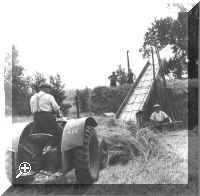
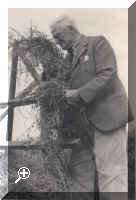
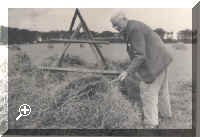
Lord Iveagh continued to consolidate his methods and by 1967 when his
grandson, Benjamin Guinness inherited the Title and Estates, the Farming
Enterprise was on a much firmer footing.
The period from 1967 to 1992 was one of varying fortunes for British
agriculture, the shape of farming at Elveden changing to meet contemporary
needs.
Expansion and modernisation of the dairy interests continued through the
1960s and into the early 1970s. A New Dairy was built at Rakebottom for 240
friesians. Parlours replaced milk bails which permitted the milking of more cows
by fewer people. Sheep were running on more marginal land and helping to manage
the less productive heathland.
There were three farm units based on the villages of Eriswell, Icklingham and
Elveden. With three farm managers, one pig manager, one forestry manager, plus a
general manager, an accountant and surveyor.
The 1970s also saw a revolution in arable farming, with advances in
agrochemical technology enabling new heights of production to be achieved. In
sugar beet production, the introduction of soil stabilising polymers such as
Vinamul, afforded protection from windblow. In cereals, the introduction of
selective herbicides and fungicides facilitated greater control over crops and
yields.
Confident of more secure returns from arable farming, the dependence on
livestock was to change dramatically over ensuing years. The reduction in beef
herds released land for additional sugar beet production. In 1976 the area of
sugar beet was doubled from 750 to 1500 acres.
A decline in dairy incomes through the 1970s coupled with an increasing
confidence in arable production led in 1978 - 79, to a major re-appraisal of the
farming system in discussion with the Agricultural Development Advisory Service.
In 1979 the decision was made to withdraw from milk production and take the
E.E.C. Grant for doing so and to invest in irrigation systems. Milking ceased on
3rd December 1980. The staff was reduced from 178 to 110. A large majority of
those who lost their jobs chose to remain, as tenants, in their homes on the
Estate and found employment elsewhere.
Manure that had previously been available from the dairy herds was replaced
by poultry manure obtained from the rapidly expanding East Anglian broiler
industry. Money was invested in mechanisation and grain stores and other crops
were looked at - chicory, carrots and daffodil bulbs, but apart from carrots,
these were not pursued. The area of sugar beet doubled again to 3000 acres. Irrigation
systems were installed, taking advantage of the massive untapped water resource
lying in chalk aquifers beneath the estate. The scene was thus set for a new era
in farming at Elveden.
Increasing specialisation within agriculture also led to the decision in 1981
to set up the pig herds as a separate department with its own manager and staff.
Three outdoor herds were kept at that time and the change gave the opportunity
for development and expansion of pig-keeping in Elveden.
In 1982 Fusilade was introduced, this chemical supplies the means to kill the
grass and cereals in broad-leaved crops. Drilling barley as a cover crop for
sugar beet, carrots, parsnips and onions to prevent sand-blow was now possible
and when established the barley could be sprayed off. It enabled a much wider
range of crops to be grown on the blowing sands of the Breckland, where
irrigation was available.
In 1985 more potatoes, parsnips and onions were introduced as irrigation
increased.
In 1986 the beef herd was sold.
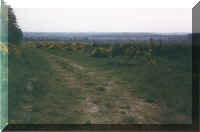 The late 1980s also heralded a change in political
attitudes towards agriculture and land use. The concept of direct financial
support for food production was becoming less popular and the need to give
priority to maintaining an ecologically diverse environment recognised. This was
not a new concept for the owners of Elveden Estate who had protected large areas
of unimproved heathland
The late 1980s also heralded a change in political
attitudes towards agriculture and land use. The concept of direct financial
support for food production was becoming less popular and the need to give
priority to maintaining an ecologically diverse environment recognised. This was
not a new concept for the owners of Elveden Estate who had protected large areas
of unimproved heathland 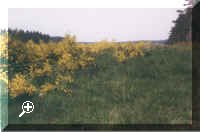 way back in the early part of the 20th century.
This voluntary conservation of habitat has been gradually
embraced by legislation, firstly by the designation of these areas in the 1960s
as Sites of Special Scientific Interest (SSSI), then by establishment of the
whole of Breckland as an Environmentally Sensitive Area (ESA), in the 1980s.
This has been further reinforced by European Legislation during the 1990s and
into the new century. Large areas of Elveden estate are now protected by statute
and managed in a manner intended to maintain and improve their contribution to
the rural environment.
way back in the early part of the 20th century.
This voluntary conservation of habitat has been gradually
embraced by legislation, firstly by the designation of these areas in the 1960s
as Sites of Special Scientific Interest (SSSI), then by establishment of the
whole of Breckland as an Environmentally Sensitive Area (ESA), in the 1980s.
This has been further reinforced by European Legislation during the 1990s and
into the new century. Large areas of Elveden estate are now protected by statute
and managed in a manner intended to maintain and improve their contribution to
the rural environment.
In 1992, Edward, Lord Elveden, became Earl of Iveagh. Continuing the process
of change and development, adapting to contemporary need and maintaining the
high profile afforded it by previous generations.
In 1997 the specialist nature and importance of vegetable production was
reflected in a reorganisation of the farm structure. Specialist teams were set
up to look after vegetable production and arable cropping over the whole farm.
Further investment in irrigation was undertaken including the securing of water
supplies by construction of two water storage reservoirs.
Identification of rhizomania disease of sugar beet in 1997 led to a complete
withdrawal from growing this crop by the year 2000.
Pig production also underwent further development during the late 1990s, the
three outdoor herds were replaced by a single outdoor herd of 1500 breeding
sows. New animal housing was established to accommodate their progeny to
slaughter weight.
Cattle and sheep have not completely disappeared from the Elveden scene,
although their importance has varied over the years. Changing practices in
heathland management and an availability of arable by-products has given rise to
a resurgence in numbers at the turn of the new century. The livestock business
now includes a herd of 200 South Devon beef cows with pedigree Aberdeen Angus
and Charolais bulls, some of which have been brought over from Lord Iveagh's
farm in Ireland. Sheep continue to tread the land as they have for centuries.
The Estate Farm is the largest lowland arable holding in England.
The development of the Elveden Estate throughout the 20th century has been
dominated by a single recurring theme: That is the acceptance of the need to
change to meet contemporary need. The willingness and commitment of successive
generations of the owners, managers and communities of the Elveden Estate to
embrace change, is probably the single most important reason why this Estate
remains intact and thriving to this day.
Some interesting facts:-
Food production on the Elveden Estate:
Annually:
Potatoes: 22000 tonnes for supermarkets, Walkers Crisps, McDonalds Fries.
Onions : 18000 tonnes for supermarkets, onion rings, Branston Pickle.
Carrots : 16000 tonnes for supermarkets and prepared meals.
Parsnips : 6000 tonnes for supermarkets.
Wheat: 4000 tonnes for bread making.
Rye: 2500 tonnes for Ryvita, bakery products and mushroom spawn.
Barley: 2800 tonnes for animal rations.
Peas: 800 tonnes for animal rations.
Pigs: 30000 animals for bacon
©2000 Yvonne Vincent, W.M. Sloan, L. Hargreaves and Gillian Turner.
[Ref: Some source material obtained from: "A Man of his Time" - A
Life of the First Earl of Iveagh, K.P., G.C.V.O. "The Elveden
Enterprise" and "The Elveden Estate" 1953 -1963 all by George
Martelli.]
Photographs of the Earls of Iveagh and the Estate used with the kind permission of
Lord Iveagh.
